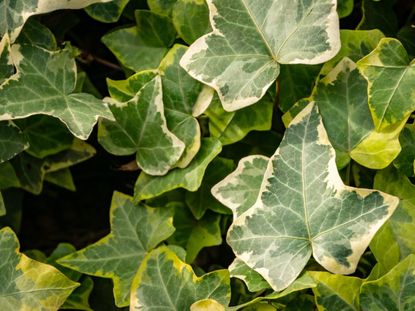Information On Care Of A Variegated Ivy Plant


When it comes to indoor plants, a variegated ivy plant can add some sparkle and jazz to an otherwise boring room, but the care of a variegated ivy differs somewhat from the care of other kinds of ivy. Read on to learn more about variegated ivy care.
Basic Care of a Variegated Ivy Plant
Variegated ivy leaves will typically have green and white or yellow markings. The white and yellow areas on the variegated ivy leaves lack chlorophyll. Chlorophyll serves many purposes, the main ones being producing food for the variegated ivy plant and protecting the plant from the rays of the sun. This means that because of the variegation, variegated ivy care is slightly different than normal green ivy care. First, a variegated ivy plant needs less sunlight and it must be placed out of direct sunlight. Proper care of a variegated ivy requires that you place the ivy plant in indirect or filtered bright sunlight. Variegated ivy leaves will burn if placed in direct sunlight. Variegated ivy will do best on a window sill behind a sheer curtain. The second secret to variegated ivy care is to significantly reduce the amount of fertilizer you give the plant. Because variegated ivy leaves have less chlorophyll, the plant produces less energy for growth. This means variegated ivy plants grow much slower than their all green cousins. Because they grow slower, they need much less food in the soil. The best fertilizer care of a variegated ivy is to fertilize only once a year, at most. Even then, do so only lightly. If you fertilize your variegated ivy any more than this, excess fertilizer will build up in the soil and can kill your plant.
Keeping Variegated Ivy Leaves Variegated
Variegated ivy leaves are caused by a genetic factor in the ivy plant, but, without proper variegated ivy care, a variegated ivy plant can revert to the more standard green leaves. One key factor is sunlight. While a variegated ivy plant can't take direct sunlight, they do need bright sunlight. Without bright sunlight, the plant cannot make enough food from its chlorophyll to support itself. In order to survive, the plant will start to grow leaves with more green area. If left like this, the plant will eventually grow only green on the leaves. If this occurs, move the plant to brighter sunlight. The variegated ivy leaves should return over time. Occasionally, a variegated ivy plant will spontaneously revert to green leaves. You will know if this occurs because only part of the plant will be growing green leaves while the rest is fully variegated. If this happens, simply trim off the non-variegated ivy leaves to encourage growth of the right colored leaves.
Gardening tips, videos, info and more delivered right to your inbox!
Sign up for the Gardening Know How newsletter today and receive a free download of our most popular eBook "How to Grow Delicious Tomatoes."

Heather Rhoades founded Gardening Know How in 2007. She holds degrees from Cleveland State University and Northern Kentucky University. She is an avid gardener with a passion for community, and is a recipient of the Master Gardeners of Ohio Lifetime Achievement Award.
-
 Grow a Bathroom Oasis: 8 Best Bathroom Plants With No Light or Low Light
Grow a Bathroom Oasis: 8 Best Bathroom Plants With No Light or Low LightSome apartment dwellers grow the best bathroom plants with no light or low light. Read how one of our favorite plant lovers does it in the big city.
By Teo Spengler
-
 "My Worst Mistake" – Gardeners Share 10 Hard-Learned Lessons
"My Worst Mistake" – Gardeners Share 10 Hard-Learned LessonsGardeners never stop learning, and sometimes our mistakes are the best teachers. But why not save time and heartache by learning from other gardeners' failures?
By Melanie Griffiths
-
 What Is Persian Ivy – How To Grow A Persian Ivy Plant
What Is Persian Ivy – How To Grow A Persian Ivy PlantHedera colchica, also called Persian ivy, is a shade garden staple with good erosion control properties. Read on for more.
By Becca Badgett
-
 Ivy Turning Yellow: Reasons For Yellowing Leaves On Ivy Plants
Ivy Turning Yellow: Reasons For Yellowing Leaves On Ivy PlantsEven the hardiest of ivies may succumb to the occasional problem and develop yellow leaves. Ivy plant leaves turning yellow are rarely serious, though you should make some changes. Read here for help.
By Kristi Waterworth
-
 Ivy Plant Propagation: Best Way To Root An Ivy Cutting
Ivy Plant Propagation: Best Way To Root An Ivy CuttingBuying a lot of ivy for large plantings can be an expensive proposition, but you can get a large batch for free by rooting ivy plants in your home. Propagating ivy is simple, and this article will help.
By Anne Baley
-
 Ivy Houseplants - Information On Caring For Ivy Plants
Ivy Houseplants - Information On Caring For Ivy PlantsGrowing English ivy indoors is a great way to enjoy this attractive vine without setting it loose in the garden.
By Heather Rhoades